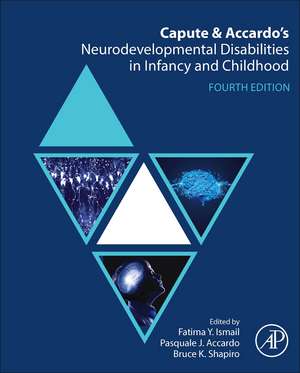Capute and Accardo's Neurodevelopmental Disabilities in Infancy and Childhood
Editat de Fatima Y Ismail, Pasquale J. Accardo, Bruce K Shapiroen Limba Engleză Hardback – 15 noi 2024
The book's practical, expert-led approach aims to prepare future clinicians to skillfully assess and manage children with neurodevelopmental disabilities with the aid of clinical approach flowcharts to common presentations, diagnostic algorithms and clinic notes templates.
- Provides the most comprehensive, authoritative, and up-to-date single volume on practical aspects of care for patients with neurodevelopmental disabilities
- Presents a reorganized single volume that is more accessible than previous editions
- Features new chapters on telemedicine, novel therapies, care in low resource settings, and the future of neurodevelopmental disabilities
- Includes full color illustrations throughout, along with explanatory figures
- Covers clinical approaches and diagnostic algorithms and templates for clinic notes that are available for online download
Preț: 916.05 lei
Preț vechi: 1193.35 lei
-23% Nou
Puncte Express: 1374
Preț estimativ în valută:
175.32€ • 184.95$ • 146.10£
175.32€ • 184.95$ • 146.10£
Carte disponibilă
Livrare economică 06-20 decembrie
Preluare comenzi: 021 569.72.76
Specificații
ISBN-13: 9780128240601
ISBN-10: 0128240601
Pagini: 700
Dimensiuni: 191 x 235 mm
Ediția:4
Editura: ELSEVIER SCIENCE
ISBN-10: 0128240601
Pagini: 700
Dimensiuni: 191 x 235 mm
Ediția:4
Editura: ELSEVIER SCIENCE
Cuprins
Section 1. Spectrum of Developmental Disabilities
1. Definition and conceptualization
2. Typical neurodevelopment
3. What causes NDD?
4. Themes from the neuroscience of NDD
5. Clinical phenotypes of NDD: definition and examples (DSMV or ICD-10)
6. Risk/Screening and Early identification
Section 2. Diagnostic Processes
7. History and physical examination
8. Neurodevelopmental examination (age specific, standardized tools, value of serial evaluations, developmental curves, the 3 Ds: delay, dissociation and deviance)
9. Clinical formulationsi
Section 3. Etiologic Evaluation (indications, advantages, disadvantages, utility, methods, interpretation)
10. Neuroimaging: (Fetal MRI, Head US, brain MRI: structural, functional, metabolic, connectomics)
11. Genetic evaluation (karyotyping, SNP and next generation sequencing)
12. Electrophysiology
13. Neuropsychology and education
14. PT/OT
15. Speech and Language
16. Vision and hearing evaluation
17. Family functioning / social
18. Continuum of NDD expression – comorbidities and differential diagnosis
Section 4. NDD beyond the diagnosis: Management/Therapy
19. Prevention (primary, secondary and tertiary)
20. Early intervention (Utility and Futility)
21. Management vs Therapy: (intensity, duration, success, failure, costs, utility and futility)
22. Specific therapiesi
23. The medical home and interdisciplinary care
24. Community support and advocacy
25. Telemedicine
26. Management/therapy in low resource settings
27. Preparing for the many transitionsi
Section 5. Future Directionsi. Research in NDD
28. Limitations and challenges
29. From observation to intervention
1. Definition and conceptualization
2. Typical neurodevelopment
3. What causes NDD?
4. Themes from the neuroscience of NDD
5. Clinical phenotypes of NDD: definition and examples (DSMV or ICD-10)
6. Risk/Screening and Early identification
Section 2. Diagnostic Processes
7. History and physical examination
8. Neurodevelopmental examination (age specific, standardized tools, value of serial evaluations, developmental curves, the 3 Ds: delay, dissociation and deviance)
9. Clinical formulationsi
Section 3. Etiologic Evaluation (indications, advantages, disadvantages, utility, methods, interpretation)
10. Neuroimaging: (Fetal MRI, Head US, brain MRI: structural, functional, metabolic, connectomics)
11. Genetic evaluation (karyotyping, SNP and next generation sequencing)
12. Electrophysiology
13. Neuropsychology and education
14. PT/OT
15. Speech and Language
16. Vision and hearing evaluation
17. Family functioning / social
18. Continuum of NDD expression – comorbidities and differential diagnosis
Section 4. NDD beyond the diagnosis: Management/Therapy
19. Prevention (primary, secondary and tertiary)
20. Early intervention (Utility and Futility)
21. Management vs Therapy: (intensity, duration, success, failure, costs, utility and futility)
22. Specific therapiesi
23. The medical home and interdisciplinary care
24. Community support and advocacy
25. Telemedicine
26. Management/therapy in low resource settings
27. Preparing for the many transitionsi
Section 5. Future Directionsi. Research in NDD
28. Limitations and challenges
29. From observation to intervention
